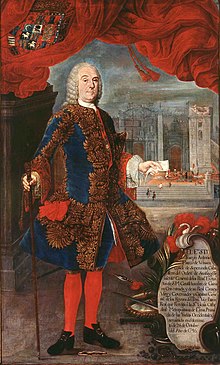José Antonio Manso de Velasco
José Antonio Manso de Velasco y Sánchez de Samaniego (baptized May 16, 1689 in Torrecilla de Cameros , La Rioja , Spain ; † May 6, 1767 in Granada , Spain) was Governor of Chile and 30th Viceroy of Peru .
Life
Origin and military career in Europe
He was born to Diego Sáenz Manso and his wife Ambrosia Sánchez Samaniego. At the age of 16, he entered the service of the Spanish crown in 1705.
In the War of the Spanish Succession he took part in the siege of Alcántara in 1706 and was wounded. In 1708 he besieged Tortosa , in 1709 in the battle of Gudina and in 1710 in the siege of Estadilla. From 1711 to 1713 he also took an active part in the war, for example in the battles of Saragossa and Villaviciosa .
He then took part in the expeditions to Cerdeña (1717) and Ceuta (1720) and fought against the English during the siege of Gibraltar (1727). He also distinguished himself in the reconquest of Oran (1732) and the wars against the Habsburgs in Italy from 1733 to 1736. At the end of his military career he had the rank of brigadier and was accepted into the Order of Santiago as a knight.
Governor of Chile
In 1735 King Philip V appointed him governor of the Philippines ; however, revoked his decision and instead gave him the post of governor in Chile. On February 1, 1737, Manso embarked on board the Conquistador in Cádiz and reached Santiago on November 11, 1737. On November 15, 1737 he took office.
One of his first official acts as governor of Chile was the convening of a meeting (Spanish: parliamento ) with the Mapuche on December 5 in the vicinity of Tapihue , with which the peace agreements of his predecessor Manuel Silvestre de Salamanca Cano were confirmed. Nevertheless, at the same time he was preparing a plan for the military conquest of the Chilean south ( Araucania ).
Manso was commissioned to implement the Bourbon policy of the strong central state in the colonies. For this purpose, too, he founded numerous cities. The following cities were founded by José Antonio Manso de Velasco, at that time some with different names:
- Cauquenes ( Nuestra Señora de las Mercedes ), 1742
- Copiapó ( San Francisco de la Selva ), 1744
- Curicó ( San José de Buena Vista ), 1743
- Melipilla ( San José de Logroño ), 1742
- Rancagua ( Santa Cruz de Triana ), 1743
- San Felipe , 1740
- San Fernando , 1742
- Talca ( San Agustín de Talca ), 1742
Under his direction, the first public market hall was built in Santiago, and he also ordered dams to be built on the Río Mapocho for flood protection.
Viceroy of Peru
On December 24, 1744, he was promoted to Viceroy of Peru. On June 4, 1745 he took office in Lima . As an interim successor in the office of governor, he appointed Francisco José de Ovando . In 1746 the Peruvian cities of Lima and Callao were destroyed by a severe earthquake , killing more than 10,000 people. He had the cities rebuilt. In 1747 he founded Bellavista between Lima and Callao.
In 1748 King Ferdinand VI promoted him . to the Conde de Superunda .
In 1750 he was able to uncover and prevent a planned Indian revolt. In 1755 he completed the first phase of the reconstruction of the Lima Cathedral .
In 1758, at the age of 69, Manso asked the king for his retirement. This request was granted to him in 1760. On October 12, 1761, he handed over the office of Viceroy of Peru to Manuel d'Amat i de Junyent .
Siege of Havana, injustice and death
He wanted to return to Europe and chose the northern route via Panama and Cuba . In October 1761 he arrived in Havana , Cuba. The British fleet attacked the city during the Seven Years' War . Manso, a seasoned officer, was appointed commander of the Junta de Guerra and headed the defense. After 67 days of siege, he had to surrender in 1762 and surrender the city to the English (who later exchanged them for Florida in the Peace of Paris in 1763 ).
José Antonio Manso de Velasco was tried before a court-martial in Spain and taken to prison in Granada. His property was confiscated. He died impoverished and out of favor in 1767 at the age of 78.
Web links
- Biography at Biography de Chile . Retrieved June 23, 2010.
- Biography from Icarito ( Spanish ) Retrieved June 23, 2010.
- José Toribio Medina : Diccionario Biográfico Colonial de Chile . Imprenta Elziviriana, Santiago, Chile 1906, p. 496–498 (Spanish, memoriachilena.cl [PDF; accessed June 15, 2010]).
| predecessor | Office | successor |
|---|---|---|
| José Antonio de Mendoza Caamaño y Sotomayor |
Viceroy of Peru 1745–1761 |
Manuel d'Amat i de Junyent |
| personal data | |
|---|---|
| SURNAME | Manso de Velasco, José Antonio |
| BRIEF DESCRIPTION | Governor of Chile, Viceroy of Peru |
| DATE OF BIRTH | baptized May 16, 1689 |
| PLACE OF BIRTH | Torrecilla de Cameros , La Rioja , Spain |
| DATE OF DEATH | May 6, 1767 |
| Place of death | Granada , Spain |



